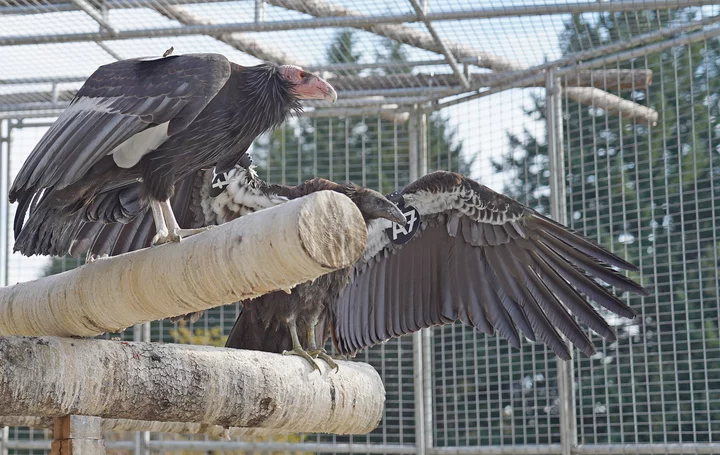A6! Photos: Yurok Tribe.
Press release from the Yurok Tribe:
At 7:30 a.m. on Wednesday, November 9, the Northern California Condor Restoration Program (NCCRP) plans to release two more prey-go-neesh (California condors) into Yurok Country. The release attempt can be viewed live on the Yurok condor cam, which can be found here (link.
The birds include A6 and A7. A6, a male, was born on May 22, 2021, at the Oregon Zoo’s Jonsson Center for Wildlife Conservation. A7, a female was born on June 2, 2021, at the Peregrine Fund’s World Center for Birds of Prey.
“I can’t wait to see A6 and A7 join the six condors in the wild,” said NCCRP Manager and Yurok Wildlife Department Senior Biologist Chris West. “Condors are an extremely social species that learn from each other. The previously released birds are adapting well to their new environment and I expect they will teach A6 and A7 how to do the same.”
A7 (foreground)!
For the release, NCCRP biologists will implement a multistep procedure to ease the juvenile birds’ transition into the wild. The process will begin as dawn begins to lighten the area around the enclosure. Before full-light, NCCRP will open the door to a baited enclosure, or trap, attached to the flight pen. This door will remain open until one or both pre-release birds enter the enclosure and when one or more of the previously released prey-go-neesh are present at the facility or near it. The presence of free-flying birds signals to the captive condors that it is safe to exit the flight pen. Once the wild birds are present and one or more of the target birds are feeding on the bait in the trap, the door between the main flight pen and the trap will be closed. Then, a second door will be opened and the birds will have access to the outside world. If only one condor walks into the staging area and the other stays in the flight pen for a certain period of time, NCCRP will release one bird.
Depending on the time of day, there may be an attempt to release the second bird. If an initial release does not occur, or if only one bird is released on day one, a second attempt will be made the following day. The condors must voluntarily enter and exit the staging area. The timing of the release is wholly dependent upon the birds’ actions. Additionally, young, captive-raised prey-goneesh are incredibly cautious. The first release unfolded in a few hours. The second and third releases took multiple days. The six released condors are beginning to explore the redwood region. Within the last month, the birds greatly expanded their range from a fairly confined area within a few miles of the release site to more 30 miles away. The young condors have spent time near Horse Mountain in Six Rivers National Forest and soared above Big Lagoon and Stone Lagoon on the coast. They have also taken several trips to Bureau of Land Management property in Lacks Creek, which is approximately 20 miles northeast of Eureka.
On May 3, 2022, NCCRP released the first condors to fly over Yurok skies in more than a century. In the following months, the program released four more birds. Yurok Wildlife Department Director Tiana Williams-Claussen selected Yurok names for each condor, which include: A0, Neygem’ ‘Ne-chween-kah (She carries our prayers); A1, Hlow Hoo-let (Finally, I/we fly); A2, Nes-kwechokw’ (He returns/arrives); A3, Poy’-we-son (The one who goes ahead); A4, Cher-perhl So-nee-nepek’ (I feel strong); and A5, Neee’n (Watcher). A6 and A7 will receive Yurok names after their release. The staggered release is one component of a comprehensive plan to ensure the success of the young birds.
NCCRP, a partnership between the Yurok Tribe and Redwood National and State Parks, plans to reintroduce one cohort of prey-go-neesh every year for at least the next two decades. The tribe and park collaboratively manage the new population.
The Yurok Tribe and Prey-go-neesh
The Yurok Tribe initiated the condor reintroduction project in 2008. The restoration of this sacred species is an important component of the Tribe’s environmental and cultural restoration work. In addition to the reintroduction of the critically endangered condor, the Tribe is currently restoring fish and wildlife habitat on a large-scale in the Klamath River and Sacramento basins. The Tribe is also intimately involved in the pending removal of four Klamath River dams, which represents the largest river restoration project in US history. The removal of the dams will benefit a wide diversity of fish and wildlife species, including condors.
With funding support from the Yurok Tribe, Redwood National Park, the U.S. Fish and Wildlife Service, the Bureau of Indian Affairs, the Administration for Native Americans, as well as Pacific Gas and Electric Company, Global Conservation Fund, the Redwood National Park Foundation, and many more corporate, agency and private supporters and citizens, the Yurok Wildlife Department completed a vast volume of work to prepare for the reintroduction of this imperiled species. Working in cooperation with the Ventana Wildlife Society, Redwood National Park, California State Parks, and Pacific Gas and Electric Company, as well as volunteers, the Tribe designed and built the NCCRP release and management facility. The flight pen includes a simulated, shock-wired power pole (to teach the birds to avoid this threat after release), two four-foot diameter pools, and perches overlooking old-growth redwood forest. NCRRP staff monitor the birds from modified shipping containers which form a fire-resistant observation structure. The facility also allows biologists and technicians to conduct regular health assessments and provide medical treatment, if necessary.


CLICK TO MANAGE